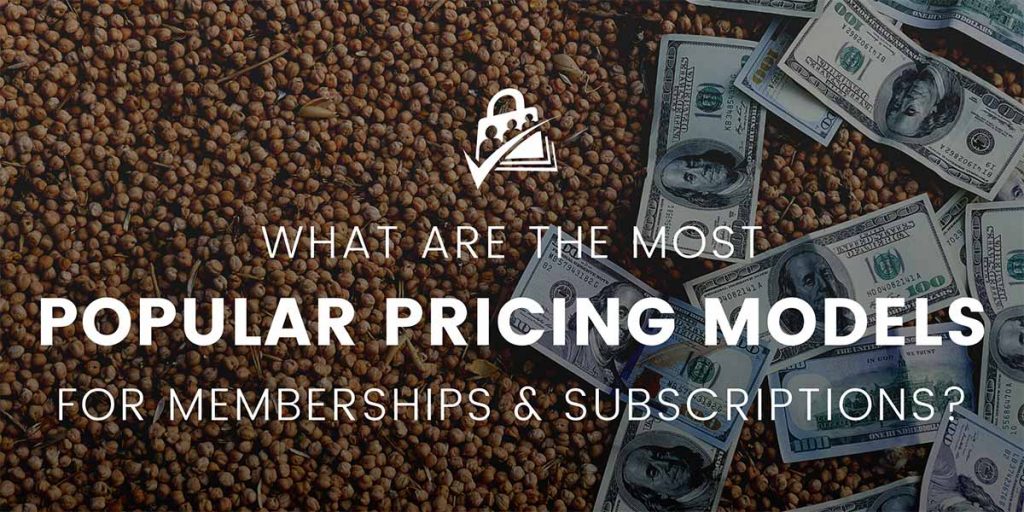Building a membership or subscription business online starts with a major decision: pricing. More specifically, what type of pricing model do you want to use for your business?
The type of pricing model you choose influences everything from member acquisition and retention to overall revenue.
This post covers the ten most popular pricing models for membership-type businesses, with examples to help you determine the best fit for your unique project.

The Price Should Always Match the Value
Before you even begin to drool over the idea of hordes of members paying you a recurring fee each week or month, ask yourself how your membership business delivers value to its members. Is value delivered evenly over the lifetime of membership? Is the majority of value delivered in the first months of membership?
The answer to this basic question is what determines how you price your membership site. Pricing your membership or subscription options in a way that is contrary to the value delivered is a set up for failure: You do not want members to stop and ask themselves, “Hey, why am I still paying for this?” as that’s a sure way to create a bad feeling and lose members.

When your customers get the receipt for their subscription—whether that is monthly, annually, or some other billing period—make sure they have recently gotten comparable value from their membership.
—Jason Coleman, Co-founder, CEO of Paid Memberships Pro
There’s another way to think about value pricing…
How Much Do You Want to Make?
Now this may seem like a silly question, the answer to which is, “As much as I can possibly make!” But if you are truly honest with yourself, you should be able to set a realistic revenue target or goal. Using this revenue target, you can back into membership pricing (and possibly even refine your business model).
For example, let’s say you set a revenue target at $30,000 per month. This could be achieved several ways:
- 750 members paying you $10/week.
- 1,000 members paying you $30/month.
- 835 or so new members per month committed to paying you $36/year.
Which of these is most achievable given the premise of your membership site? How can you deliver value along the timeline of your membership to retain these members? Is it possible for you to grow to a member base of this size?
If you’re still thinking about pricing from this high level, you might want to check out our post Membership Pricing: Basic Methods Part 1 before diving into the details below.
If you have an idea of the type of pricing you want or otherwise just want to browse through the options below, continue reading. Here are some common pricing models we have seen used for member-based businesses.
10 Popular Pricing Models for Membership Sites
1. Fixed Term Membership
In this pricing model, the membership level has a set term with expiration. Members must renew to maintain membership. We often see this pricing model used for a set term of the calendar year (January 1 to December 31). This is a common pricing model for traditional associations and organizations as well as benefactor groups that report membership on an annual basis and require people to “renew” that term each year.
You can do some creative things with this pricing model, such as offer a discount for early renewal, a discount for purchasing a multi-year membership in advance, or even prorate membership for people who sign up mid-term.
For more reading on this model, see:
- How to Set All Member Subscriptions to Renew on the Same Date or Schedule
- Allow Members to Select Auto-Renewal via Checkbox on Membership Checkout [New PMPro Plus Add On]
- Provide a Discount for Early Membership Renewal
- Offer Expired and “Old” Members a Membership Renewal Discount for Coming Back
- Prorate Payments with the Proration Add On with Paid Memberships Pro
2. Recurring Subscriptions with Fixed Price per Period
This is a very popular model of membership pricing, where a specific price is charged “per month” or “per year” for the life of membership. Most payment gateways also allow pricing per week or custom periods like every 3 months, every 60 days, etc.
Recurring subscriptions work well for newsletter-based businesses, sites with content written by “experts” or coaches, as well as online social communities and listings sites.
The important caveat to this type of membership pricing is that you continue to deliver value each term. If your members are paying you monthly, you better be certain that there is “new stuff” (good new stuff) delivered to the member each month.
This model is very easy to set up with the core Paid Memberships Pro plugin. You would achieve this by setting an initial payment and recurring subscription of the term of your membership.
3. Front-Loaded Membership Pricing
Jason is a fan of front-loaded pricing models—where a higher amount is charged at signup, then a lower rate is charged each term. This can be a single upfront higher cost, or an installment (i.e. $100 per month for the first 3 months then $15 per month).
This is a best model when most of your value is delivered in the first few months (or weeks). I see this pricing model for health and fitness sites aimed at weight loss or a software businesses with a “get started” rate followed by a maintenance rate.
For more reading on this model, check out our post How to Front-Load your Membership Pricing and Double Revenues.
4. Installment Plans
Installment plans are a bit like the front-loaded membership, but they do not have the ongoing recurring payment. This model is useful if you need to charge a high price but know that your customers cannot afford that large expense in one payment. I have seen this model used for executive coaching, training programs, and the sale of physical goods.
This model is very easy to set up with the base Paid Memberships Pro plugin. You would achieve this by setting an initial payment and recurring payment of the term of your membership, with a “payment limit”. You can optionally set an expiration date on membership as well. Let me break this down for a membership level that you want to charge $400 for over the course of 4 months and maintain the user’s membership for 1 total year.
- Initial Payment: $100
- Recurring Subscription: $100 per 1 month
- Billing Cycle Limit: 3
- Expires in: 1 Year
One caveat of an installment plan is that you want to lock a member in to paying for the full installment. If you’re giving a customer a $400 physical product, and they cancel membership in the second month, you are out a big chunk of money. See this guide for help on locking a user from changing their level during the installment period: Methods to Block Users from Logging In, Selecting or Changing Membership
5. Free or Reduced-Rate Trial Periods
The free trial model charges a lower rate for the first few terms of membership, hoping to hook the customer into maintaining their membership after the trial ends. You will see this model used in a lot of online software and tools. It’s also popular for “subscription boxes” (get your first box – just pay shipping!), digital communication, and financial tools.
Trial periods add a ton of pressure to your business. You must prove the worth of your full price membership during the trial period.
- You don’t want to price yourself so high that people are not able to maintain membership at the full rate, and
- You don’t want to deliver all the value of membership during the trial. If you do, why would anyone stay on past the trial period?
In practice, we recommend offering a reduced-rate trial instead of a completely free trial. This forces members to make a small financial commitment to your product. By taking some payment, you’re protected from getting loads of free trial members that never really intended to stick around.
For more reading on this model, see:
- Add a 30 day free trial to an annual payment plan
- Offer Trial Memberships That Can Only Be Used Once
- Methods to Block Users from Logging In, Selecting or Changing Membership
- Restrict Discount Code Usage to One Time Per User
6. Lifetime Membership
You can add a “lifetime” option to almost any pricing model you select. Sometimes a reduced-price lifetime plan is offered for a limited time as an incentive for early adopters. Sometimes the lifetime plan is always available for customers who just want to pay once without worrying about recurring subscriptions.
To figure out what to charge for your lifetime plan, you would take some multiple of your monthly membership, perhaps 30x a monthly membership or 2.5x an annual membership rate. Ideally, your lifetime plans should result in the same “customer lifetime value” as someone paying per period. So having a good estimate of your renewal rates and customer lifetime value will help you to find the sweet spot.
Sometimes a higher-priced lifetime plan can be used as a decoy and will not be selected by a significant number of people, but will make your regular price look like a better deal. We have heard from some sites with lower-volume, higher-priced lifetime plans report that “every once in a while you get a little bonus when someone chooses the lifetime option.”
This model is very easy to set up with the base Paid Memberships Pro plugin. You would achieve this by simply setting a one-time initial payment on the membership level with no recurring subscription or expiration.
7. Group Pricing / Sponsored Membership / Umbrella Plans
This model is useful when you have a breakdown of individual members as well as corporate or company-type members. For this model, you would take your individual member pricing and offer a value to the parent account that is purchasing more than one membership at a time for a team of people. Here’s an example: offer a single membership for $125 per month and then a group license of $500 for a 5-member organization.
For more reading on this model, see:
- Group Accounts Add On
- Allow a Specific Number of Active Sessions with a Single User Account (Useful for Corporate, Education or Group-type Memberships)
8. Add On Pricing Models
In this “build your own” membership model, users may be charged a base price, then have the option to select additional membership features. These features may be added interest groups for a newsletter or blog category subscription, or a la carte features of membership, such as an annual resume review service, a consultation phone call or other “one-off” products. We have seen this model used for traditional newspapers that offer an online and optional physical printed edition.
For more reading on this model, see:
- Sell Access to a Single Post Category Using the Addon Packages Plugin
- Sell Access to Post Categories “à la carte” Using Price-Adjusting Register Helper Fields
- Addon Package Add On
9. Utility Pricing
In this pricing model, users are charged based on some kind of consumption metric. You may recognize this model as used by most email marketing services that charge based on number of members in your list. Cloud hosting companies might charge based on the disk space and/or bandwidth used.
We wanted to include this pricing model even though Paid Memberships Pro doesn’t offer utility pricing in the core plugin or any of our add ons. It can be a smart model if the cost to you as a business is truly based on a member’s usage.
- Some gateways like Stripe and Braintree allow you to adjust a user’s subscription amount whenever you like.
- Others like PayPal offer changes within a certain range.
With some custom coding, you could track the metric you need to calculate the monthly/annual total, generate an order for that, and then attempt to resolve that order against the customer’s credit card stored at the gateway.
10. Donations or “Pay What You Want” Membership
If you go the route of a donation-based membership, it is best to enter into things with low expectations. These types of membership sites are often run by producers who would be doing their thing regardless of payment. If you are a passionate product reviewer or write your own digital music and just want to get your stuff out there, then asking for optional donations can be a positive way to make a modest income without the pressure of a traditional membership model.
We like the “Pay What You Want” model, especially if you put some social pressure on your potential members: “Most people pay $5 per month.” Another option is to include bonuses above a certain amount to encourage higher revenue per sale.
For more reading on this model, see:
- Collect an Optional Donation at Membership Checkout
- Allow users to “set their own price” for membership
- Donations Add On
- Variable Pricing Add On
Pricing Model FAQs
Start by evaluating how value is delivered to your members. If the value is consistent over time, a recurring subscription might be best. If most value is delivered upfront, consider front-loaded pricing or installment plans. Also, consider your target revenue and member base size to choose a sustainable model.
Yes, combining models is totally fine. For example, you could offer a recurring subscription with an option for a lifetime membership or use add-on pricing to allow members to customize their experience.
Calculate the lifetime value of a typical recurring member and use that as a baseline. A common approach is to set the lifetime price at 30 times the monthly membership fee or 2.5 times the annual fee.
Absolutely. As your business evolves, you may find that a different pricing model is a better fit. Always communicate changes to your members and support legacy plans if you can.
Final Thoughts: Pricing Models for Memberships
The goal of this post was to expose the traditional and not-so-traditional ways you can price your new membership or subscription-based business.
From fixed-term memberships to flexible “pay what you want” models, each approach has a place, along with unique benefits and challenges.
There is no “best” model that applies to all subscription businesses. For your project, the right model is that one that best links the value you deliver to your members—only then can you align your pricing strategy accordingly.
- Don’t be afraid to experiment.
- Be open to changing your pricing model as your business grows. We did that here at Paid Memberships Pro when we put more of a focus on value pricing.
Remember, the ultimate goal is to create a sustainable revenue stream while providing consistent value to your members.

